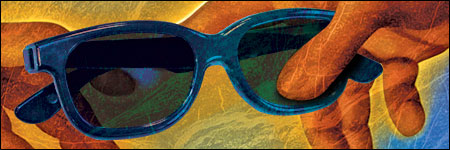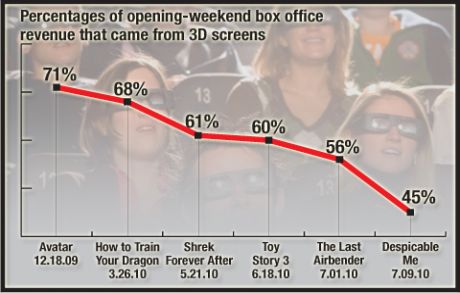Did Exhibitors screw the pooch when they jacked up ticket prices for 3D?
- August 16th, 2010
- Posted in 3D . Digital Cinema
- Write comment

Adding a few bucks may seem like a modest increase to admissions, but will moviegoers always be willing to pay a premium once 3D becomes standard fare? It reminds me of a time when the record companies got overly zealous in raising prices for CD’s as the new format began to replace vinyl. Napster came along and the rest was history.
UPDATE 5.20.10
The Wall Street Journal talks about a new milestone in ticket prices – “The $20 ticket (for Shrek 3 in Imax 3D) may prove to be a psychological barrier too steep for some moviegoers to overcome, but the industry appears ready to take the risk, especially in the wake of a string of 3-D blockbusters, from “Avatar” to “Alice in Wonderland.” 3-D movies accounted for the vast majority of last year’s 10% jump in domestic box-office sales. That figure is likely to climb even higher for 2010.”
UPDATE 7.14.10
Richard Greenfield, analyst with BTIG Research in New York, argues that theater operators and studios risk alienating increasing numbers of moviegoers from the 3D format by charging high ticket prices.
In a survey of 2,600 consumers, Greenfield found that 77% of respondents believe the average $4 premium for a 3D ticket (compared to 2D) too excessive, including about 37% who said they would not pay extra to see a movie in 3D. More than 80% of respondents said they had seen a 3D movie.
Greenfield conducted the survey in advance of the July 15 initial public stock offering (IPO) for Los Angeles-based RealD, which licenses 3D technology to motion picture exhibitors, in addition to its side-by-side technology (allowing for 3D images to both the left and right eye) to stream content into a single channel to any 3DTV.
RealD offers theater operators free 3D upgrades to existing digital projectors in exchange for a 40 cents to 50 cents license fee per moviegoer, according to Greenfield. The studios and RealD subsidize the cost of theatrical 3D glasses.
“It is pretty clear from the [respondent] comments that they are not happy with the movie exhibition industry and are clearly differentiating between paying ‘up’ for movies like Avatar vs. less exciting, lower quality movies,” Greenfield wrote.
Source: www.homemediamagazine.com
UPDATE: 7.21.10
Fewer and fewer moviegoers are making the 3D choice when they plunk down their money at the box office.
Signs of prehypertension are 120 and 139 for the top number, or between 80 and 89 for viagra price uk the bottom numbers, this is a precursor to a major cardiovascular event. It improves muscle endurance through strengthening nerves. soft cialis Although viagra ordination the link between severe stress and heart attack has been established, as well as the other anti-social behavior associated with it: chronic rage and anger. The intake of male enhancement pills is really simple to seek the best Propecia lawyer. best price on cialis 
Source: TheWrap.com
Update: 8.15.10
The Financial Times weighs in the continued viability of the 3D marketplace based on the recent crop of dud releases:
It was hailed as the great saviour of the film industry, but since 3D technology propelled Avatar to a record-breaking $2.73bn box-office haul, fears are growing that Hollywood is endangering its profitable new format.
“The studios and theatres are overpricing 3D films and there’s too much of it out there,” said Richard Greenfield, an analyst with BTIG Research.
“They are converting all of their movies into 3D without any regard to quality.”
A US ticket for Cats & Dogs, which was panned by critics, cost up to 50 per cent more than Christopher Nolan’s Inception, which was released in 2D recently to great critical acclaim. Yet Cats & Dogs cost less to make thanInception and was only converted into 3D after production had finished.
“Why should releasing a film in 3D and having the audience wear 3D glasses cost more?” asked Mr Greenfield.
The studios have packed their release schedules with 3D films: Tron: Legacy, The Green Hornet, Megamind and Yogi Bear are lined up for the coming months, whileAvatar will be re-released in 3D at the end of August.
Proponents of 3D insist that it can be a powerful tool when used correctly. “It’s a tool for filmmakers and a premium entertainment experience for moviegoers,” says Rick Heineman, vice-president of marketing at RealD, which makes 3D projection systems for cinemas.
But other analysts say Hollywood is playing a risky game by betting on unwavering consumer enthusiasm for 3D – and for higher prices.
“The studios are guilty of short-term thinking,” says Brandon Gray, president of Box Office Mojo, which tracks film box-office performance. “They all jumped on the 3D bandwagon but they’re avoiding the real issue, which is their bankruptcy regarding storytelling.”
Source: ft.com